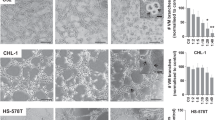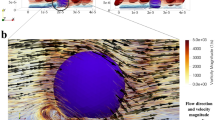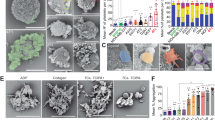Abstract
In this study we have investigated the role of thrombospondin (TSP) as a possible ligand playing a key role in human M3Da. melanoma cell interaction with platelets and in tumour growth. TSP is secreted (80 +/- 6 ng TSP 10(-6) cells) and bound to the surface of M3Da. cells via receptors different from CD36, as shown by biosynthetic labelling and immunofluorescence studies. The levels of TSP binding to M3Da. cells evaluated by binding studies, using an anti-TSP monoclonal antibody (MAb) (LYP8), shows 367,000 +/- 58,000 (mean +/- s.d.) LYP8 binding sites per cell with a dissociation constant (Kd) of 67 nM. TSP binding to M3Da. cells shows 400,000 +/- 50,000 TSP binding sites per cell with a Kd of 10 nM. The capacity of anti-TSP MAb (LYP8) to inhibit M3Da.-platelet interactions was followed on an aggregometer and evaluated by electron microscopy studies. The biological role of TSP binding to M3Da. cells was investigated by implanting subcutaneously the M3Da. cell line in nude mice and following the size and time of in vivo tumour growth. Reducing the availability or the functional level of TSP by using an anti-TSP MAb (LYP8) resulted in a significant decrease in platelet aggregates interacting with M3Da. melanoma cells. Using an enzyme-linked immunosorbent assay, purified alpha nu beta 3 was shown to bind TSP. Moreover, LYP8-coated M3Da. cells showed a reduced capacity to form tumours in vivo. M3Da. cells were observed to attach and spread on human platelet TSP-coated plastic wells. This attachment by M3Da. cells was inhibited in a similar way by LYP8 and an anti-alpha nu beta 3 MAb (LYP18). The results obtained in this study show that TSP secreted and bound to the surface of a human melanoma cell line (M3Da.) acts as a link between aggregated platelets and the M3Da. cell surface. Moreover, these results shows that TSP can modulate tumour growth in vivo. Reagents such as MAbs directed against TSP and peptides derived from TSP could not only be used as a new therapeutic approach in the control of tumour metastasis of melanoma, but may also contribute to elucidation of the role of TSP in cancer biology.
This is a preview of subscription content, access via your institution
Access options
Subscribe to this journal
Receive 24 print issues and online access
$259.00 per year
only $10.79 per issue
Buy this article
- Purchase on Springer Link
- Instant access to full article PDF
Prices may be subject to local taxes which are calculated during checkout
Similar content being viewed by others
Author information
Authors and Affiliations
Rights and permissions
About this article
Cite this article
Boukerche, H., Berthier-Vergnes, O., Tabone, E. et al. Thrombospondin modulates melanoma-platelet interactions and melanoma tumour cell growth in vivo. Br J Cancer 72, 108–116 (1995). https://doi.org/10.1038/bjc.1995.285
Issue Date:
DOI: https://doi.org/10.1038/bjc.1995.285
This article is cited by
-
Microdialysis Combined with Proteomics for Protein Identification in Breast Tumor Microenvironment In Vivo
Cancer Microenvironment (2011)
-
Role of PLZF in melanoma progression
Oncogene (2004)



